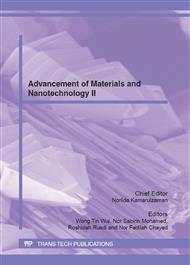p.157
p.161
p.165
p.169
p.175
p.182
p.185
p.190
p.195
Mesoporous Tin Phosphate as Anode Material for Lithium-Ion Cells
Abstract:
Mesoporous SnP2O7 was synthesized via a surfactant templating method where an anionic surfactant, sodium dodecyl sulfate was used. X-ray diffraction (XRD) analysis indicates presence of mesostructure when the precursors were calcined at 200, 300 and 400 °C. Cyclic voltammetry tests carried out within 0-2.0 V (vs. Li/Li+) indicated that irreversible reduction of tin phosphate to form lithium phosphate phases and metallic tin occurred around 1.10 V and 0.69 V whereas the reversible alloying and de-alloying reaction involving lithium with tin occurred at 0.19 V and 0.52 V, respectively. Galvanostatic charge-discharge cycling tests carried out within 0-1.2V (vs. Li/Li+) showed that the mesoporous tin phosphate calcined at 400 °C exhibited a reversible discharge capacity of 738 mAh/g in the second cycle and upon reaching the tenth cycle, it retained a discharge capacity of 461 mAh/g. The relatively high capacity obtained for this anode was attributed to the mesoporous framework which provided larger surface area for reaction with lithium and minimized effect of volume changes experienced by the anode during repeated charging and discharging cycling.
Info:
Periodical:
Pages:
175-181
Citation:
Online since:
July 2012
Authors:
Price:
Сopyright:
© 2012 Trans Tech Publications Ltd. All Rights Reserved
Share:
Citation:


